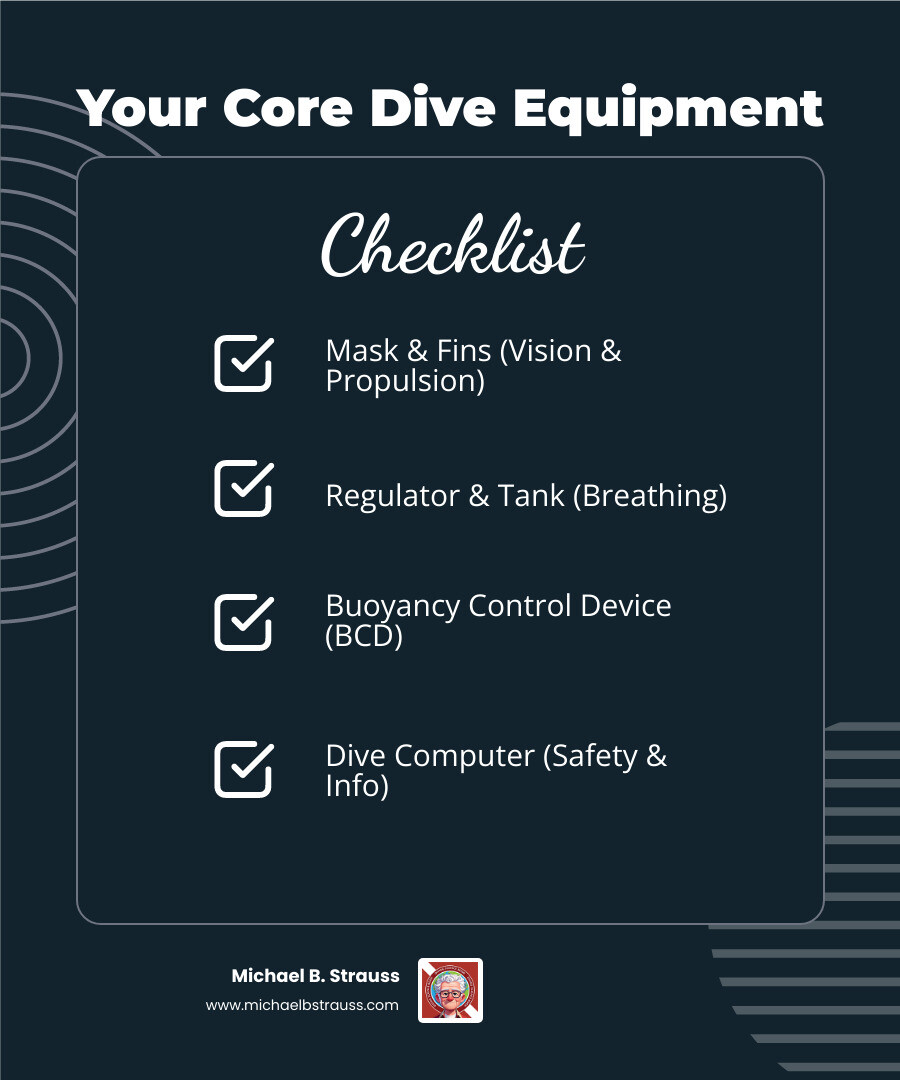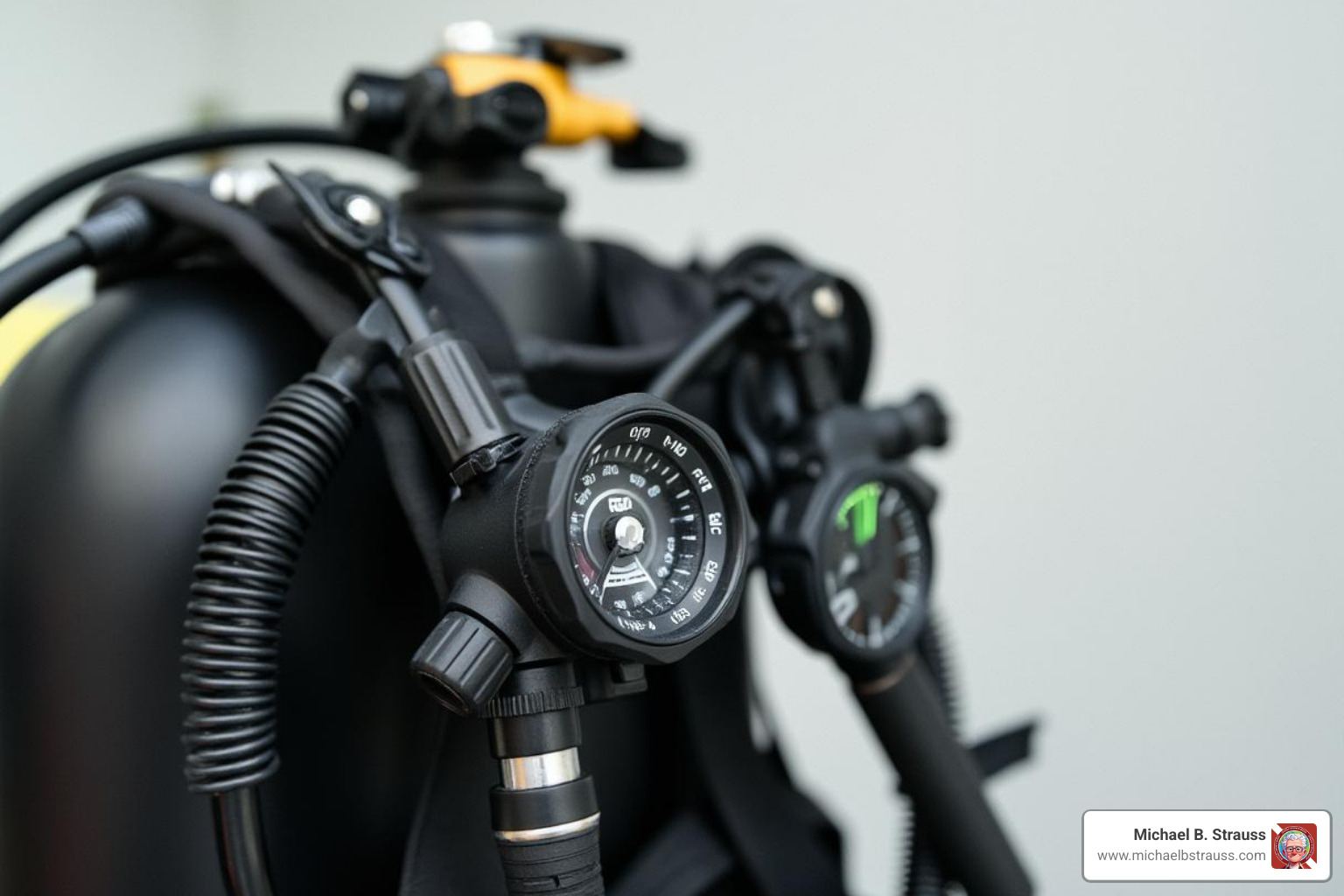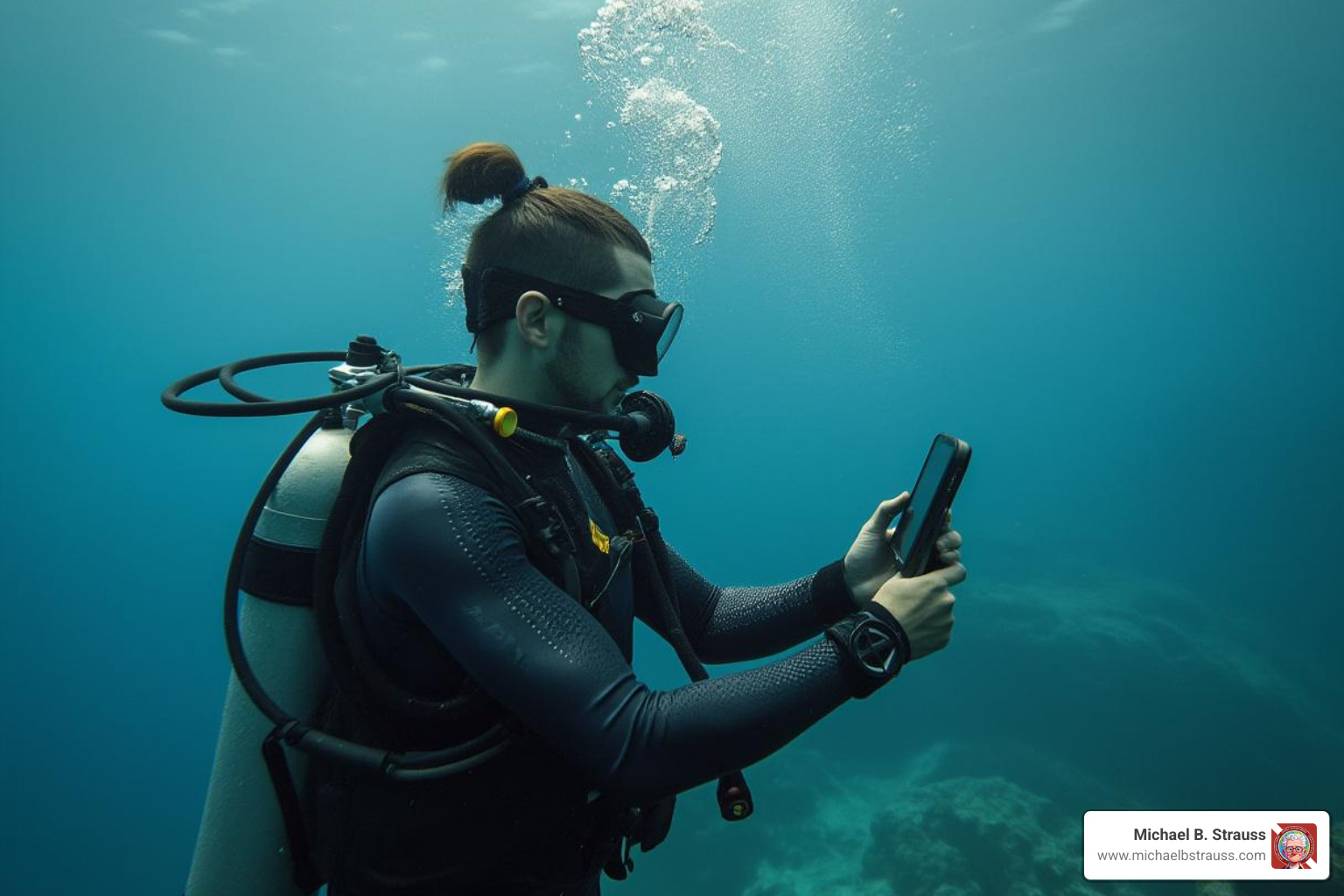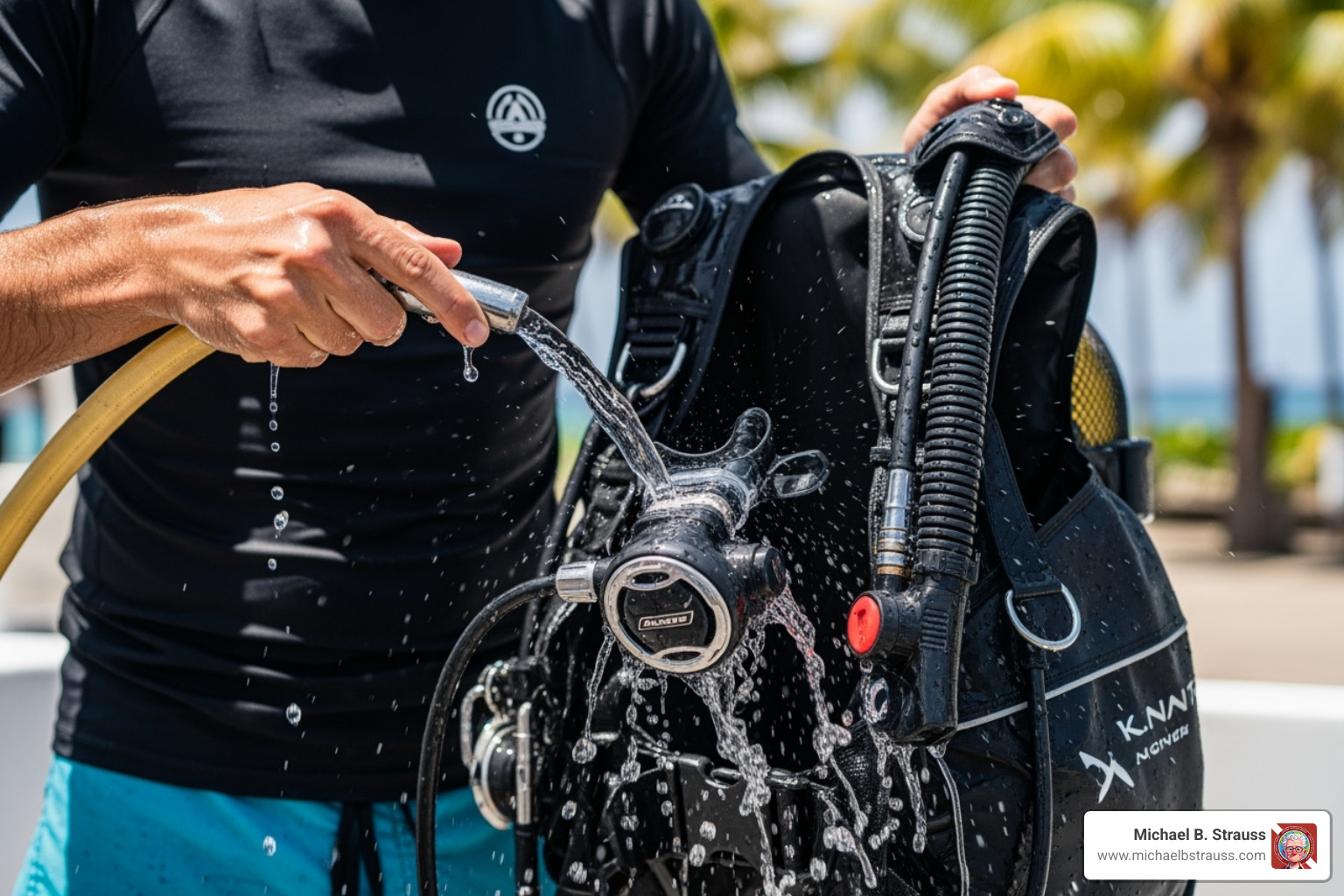Gearing Up for the Underwater World
Scuba diving opens a world beneath the waves. Before you explore, understanding the essential diving equipment is key. To a beginner, the gear can look confusing, and you might wonder if it's all necessary.
The answer is yes. Each piece keeps you safe and comfortable, allowing you to breathe, see, move, and control your position underwater.
Here are the core pieces of essential diving equipment you will need:
- Dive Mask
- Fins
- Snorkel
- Buoyancy Control Device (BCD)
- Regulator
- Scuba Tank
- Dive Computer
- Weights
- Wetsuit or Drysuit
This equipment lets you explore amazing underwater landscapes. SCUBA is an acronym for Self Contained Underwater Breathing Apparatus.

Explore more about Essential diving equipment:
Your Core Kit: The Essential Diving Equipment You Can't Dive Without
Each component of your essential diving equipment plays a vital role in exploring the underwater world safely and comfortably. Let's explore what each piece does and why it's important.
1. Vision and Propulsion: Your Window to the Underwater World
Our eyes aren't designed to see clearly underwater. Your mask, fins, and snorkel are the tools that solve this and allow for efficient movement.
Diving Mask
Your dive mask creates an air pocket in front of your eyes, allowing you to see clearly. It also covers your nose, which is crucial for equalizing pressure inside the mask as you descend. Fit is the most important factor when choosing a mask. To test it, hold the mask to your face without the strap, inhale slightly through your nose, and see if it stays put via suction. A high-quality silicone skirt ensures a good seal, and low-volume masks are often preferred for easier clearing. Clearing a flooded mask is a fundamental skill learned during training. To prevent fogging, scrub the inside of a new mask to remove manufacturing film. After each dive, rinse with fresh water and store it in its case.
Why it's hard to see underwater without a mask
Fins
Fins are your primary means of propulsion, allowing you to move efficiently with minimal effort. This conserves energy and lets you cover more distance. There are two main types: full-foot fins (worn barefoot, for warm water) and open-heel fins (worn with neoprene booties, for all temperatures). Choose fins based on your diving style; a medium-sized blade is a good balance for beginners.
Snorkel
A snorkel is essential for breathing comfortably on the surface while swimming to a dive site or waiting for a boat. This simple tool helps conserve the precious air in your scuba tank for when you're truly underwater.
2. Life Support Systems: Breathing and Buoyancy Control
These are the core components that allow you to breathe and control your position underwater.

Regulator
The regulator is a vital piece of essential diving equipment that makes breathing possible. It converts the high-pressure air from your tank to a breathable pressure at any depth. It consists of a first stage (connects to the tank) and a second stage (the mouthpiece). Most regulators also include a brightly colored alternate air source (octopus) for sharing air with a buddy in an emergency.
Scuba Tank (Cylinder)
The scuba tank holds your compressed breathing air. Tanks are typically made from steel or aluminum, with common sizes being 12 liters or 80 cubic feet. An 80-cubic-foot tank lasts about 45 minutes, depending on your air consumption.
Buoyancy Control Device (BCD)
The Buoyancy Control Device (BCD) is an inflatable vest that manages your buoyancy, allowing you to float, sink, or achieve neutral buoyancy (hovering motionless). It also secures the tank to your back and has D-rings and pockets for accessories. Many BCDs have integrated weight pockets, which can replace a separate weight belt. A good fit is crucial for comfort and control. Achieving neutral buoyancy is a key skill for effortless movement and protecting marine life.
More info about diving physiology
3. Safety and Information: Your Underwater Dashboard
These tools provide critical data and protection during your dives.

Dive Computer
A dive computer is your underwater dashboard, monitoring depth, time, and ascent rate to keep you within no-decompression limits. It's more accurate and flexible than traditional dive tables. They also log dives, track water temperature, and may include a compass or air integration. Beginners should choose a user-friendly model with a clear display.
Submersible Pressure Gauge (SPG)
The Submersible Pressure Gauge (SPG) shows how much air is left in your tank. It's a crucial instrument that you must monitor throughout your dive. Some dive computers have integrated air monitoring that displays this information on the computer screen.
Weight System
Weights are needed to counteract our natural buoyancy, allowing us to descend. They are typically lead and worn on a belt or in integrated BCD pockets. The amount of weight needed depends on your body composition, your exposure suit, and whether you're in salt or fresh water.
Why divers need weights to sink
Exposure Protection
Exposure protection keeps you warm and protected from scrapes and stings. Your body loses heat much faster in water than in air.
- Wetsuit: A wetsuit keeps you warm by trapping a thin layer of water that your body heats. They come in various thicknesses (e.g., 3mm, 5mm, 7mm) for different water temperatures. A snug fit is essential for it to work effectively.
- Drysuit: A drysuit keeps you completely dry and is used for colder water. It requires wearing insulating undergarments underneath and needs special training due to different buoyancy characteristics.
Beyond the Basics: Costs, Care, and Advanced Accessories
Once you have your core essential diving equipment, consider the cost, maintenance, and other accessories that can improve your dives.
What to Buy First and How Much Does Essential Diving Gear Cost?
For new divers, prioritizing purchases can make gearing up more manageable.
Start by purchasing your own mask, fins, and snorkel. A good fit is crucial for comfort and performance, and owning these items ensures better quality than most rentals.
Next, buy a dive computer. Owning your own means you'll be familiar with its operation and have a consistent log of your dives, which is a major safety benefit.
An exposure suit (wetsuit or drysuit) is another good early purchase. A personal suit will fit better and keep you warmer than a rental.
For expensive items like a regulator and BCD, consider renting different models for your first several dives. This helps you find what suits your style before making a large investment.
A full set of essential diving equipment is a significant investment, but there are options for every budget. Focus on fit and function over brand names. While the initial cost is high, owning your gear can save money over time compared to renting, especially if you dive often.
Support your local dive shop. They provide expert advice, servicing, and tank fills. Buying life-support gear from them ensures you get professional support for maintenance and repairs.
Gear Longevity and Maintenance for Your Essential Diving Equipment
Proper maintenance is key to extending the life of your essential diving equipment and ensuring its reliability.

After every dive, follow this routine:
- Rinsing: Thoroughly rinse all gear with fresh water to remove salt, sand, and chlorine.
- Drying: Air dry everything completely in a shady, well-ventilated area. Avoid direct sunlight, which degrades materials.
- Proper Storage: Store gear in a cool, dry place. Keep your BCD partially inflated, store your regulator in a protective bag, and hang wetsuits on wide hangers. Always keep your mask in a hard case.
With proper care, your gear can last for years. Your regulator and BCD require regular servicing by a certified technician to ensure they are in perfect working order.
Enhancing Your Dive: Recommended Accessories and Further Learning
Once you have your core essential diving equipment, certain accessories can boost comfort and safety.
- Surface Marker Buoy (SMB): A bright, inflatable tube to signal your location to the surface. Essential in areas with boat traffic or currents.
- Dive Knife or Cutting Tool: For safety in case of mess in fishing line or debris.
- Dive Light: Restores color at depth and illuminates crevices, useful even on day dives.
- Dry Bag: Keeps valuables and electronics dry on the boat.
- Save-a-Dive Kit: A kit with spare parts like O-rings and straps to fix minor gear issues on site.
- Dive Compass: For underwater navigation, helping you find your way back to the boat or shore.
- Underwater Camera: To capture the beauty of the marine world. Master your buoyancy skills first to protect the reef.
Understanding the science behind your gear and how your body reacts to the underwater environment is key to becoming a safe and confident diver. Dr. Michael B. Strauss, a renowned expert in diving safety, offers invaluable insights in his comprehensive diving books. These books are essential reads for both novices and experienced divers, providing a deeper understanding of diving physiology, safety protocols, and medical considerations.
To dive deeper into the science and safety of scuba diving, get your copy of Dr. Strauss's book, Diving Science Revisited.
DISCLAIMER: Articles are for "EDUCATIONAL PURPOSES ONLY", not to be considered advice or recommendations.






